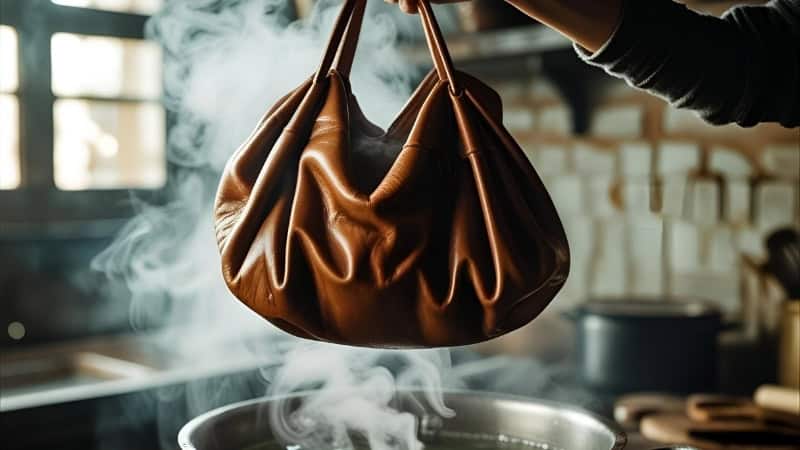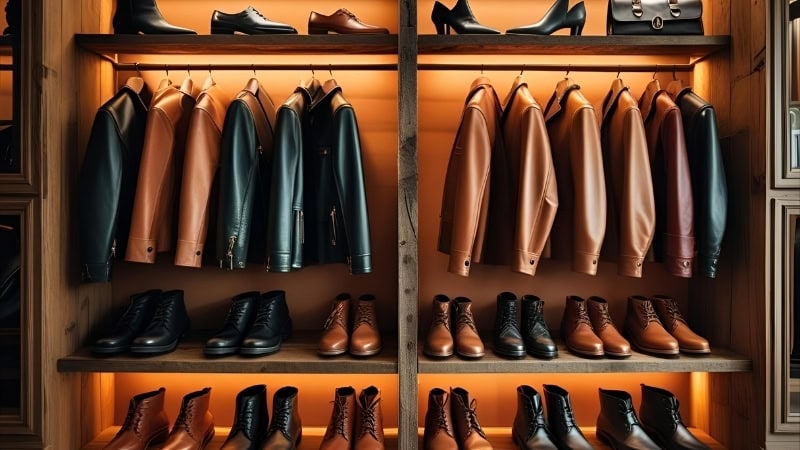Whether you have a beloved leather jacket, a cherished handbag, or a luxurious leather sofa, there’s something undeniably satisfying about owning high-quality leather. But over time, leather can develop unsightly wrinkles that can mar its elegance.
If you’ve ever been frustrated with the creases and wrinkles appearing on your leather goods, you’re not alone. Leather wrinkles can occur for various reasons—perhaps due to improper storage, regular wear and tear, or even environmental factors like humidity and heat.
But fear not. With the right knowledge and techniques, you can smooth out those wrinkles and bring your leather back to life, making it look just as stunning as the day you bought it.
Let’s dive into how you can unwrinkle leather.
Recommended Read: Leather vs Leatherette – Which One to Go for?
Understanding Different Types of Leather Wrinkles
Before we jump into solutions, it’s important to understand why leather wrinkles in the first place. Leather is a natural material, and just like skin, it can show signs of age and stress. Some wrinkles are completely normal, while others may indicate damage. Let’s take a closer look at the different types of leather wrinkles.

1. Natural Wrinkles vs. Damage: What’s the Difference?
Natural wrinkles are a characteristic of leather that adds to its charm and uniqueness. Leather, especially high-quality types like full-grain and top-grain leather, has natural imperfections and textures that come with its organic nature. These wrinkles are part of the leather’s story—whether from the animal’s natural movements or the aging process of the leather itself.
On the other hand, damage-related wrinkles are more serious. These might include deep creases, cracks, or tears caused by neglect, improper care, or harsh conditions. Distinguishing between natural wrinkles and damage can save you from unnecessarily trying to fix something that’s just a part of the leather’s character.
2. Common Types of Leather: Which Ones Wrinkle More?
Not all leathers behave the same way. Some types are more prone to wrinkles, while others might hold their shape better.
- Full-grain leather: The highest quality leather. It’s strong and tends to wrinkle naturally over time, but these wrinkles add to its beauty.
- Top-grain leather: Also high quality but tends to be less flexible than full-grain, making it prone to fewer wrinkles.
- Genuine leather: Usually made from a blend of leather pieces. It’s more likely to wrinkle easily since it’s not as robust as the higher-quality types.
- Bonded leather: The most susceptible to wrinkling and cracking, as it’s made from leather scraps and mixed with other materials.
Understanding the type of leather you’re dealing with will help you decide on the best course of action to smooth those wrinkles out.
Methods for Unwrinkling Leather: Step-by-Step Techniques
Now, let’s talk about how to get rid of those wrinkles. Whether you’re dealing with a small leather accessory or a large piece of furniture, there are several methods to get your leather looking smooth again. Let’s explore the most effective techniques, with solutions that range from easy DIY approaches to professional options.
1. Using Heat to Remove Leather Wrinkles
One of the quickest ways to get rid of wrinkles in leather is by applying controlled heat. The heat helps relax the leather fibers and smooth them out. But it’s important to apply heat carefully, as too much can damage the leather.
Iron Method:
- Set your iron to the lowest heat setting (no steam!).
- Place a cotton cloth or a thin towel over the wrinkled area.
- Gently press the iron onto the towel for a few seconds.
- Check the leather regularly, and avoid holding the iron in one spot for too long.
Hair Dryer Method:
- Turn on your hair dryer to a medium heat setting.
- Hold the dryer about 6-8 inches from the wrinkled leather surface.
- Move the hair dryer around the area, ensuring you don’t focus on one spot for too long.
- Gently massage the area with your hands to encourage the leather to soften.
Important Tip: Never place the iron directly on the leather or apply excessive heat. Leather is delicate and can burn or warp if not handled properly.
2. Moisturizing: Rehydrating Leather to Smooth Out Wrinkles
Just like human skin, leather needs moisture to stay supple. Lack of moisture can cause leather to dry out, leading to wrinkles and stiffness. Rehydrating leather can help relax those wrinkles and restore its natural flexibility.
Recommended Read: Non-Toxic Leather Conditioner: Safe, Natural, and Effective Leather Care
Leather Conditioners:
- Use a high-quality leather conditioner or balm to restore moisture.
- Apply a small amount of conditioner to a soft cloth and gently rub it into the leather.
- Allow it to absorb fully before polishing the surface to a nice shine.
Water Vapor:
- Boil a pot of water and hold the leather (at a safe distance) over the steam for a few minutes.
- As the leather softens, gently rub or massage the wrinkles to smooth them out.
Homemade Solution:
- Mix equal parts water and white vinegar in a spray bottle.
- Lightly spritz the wrinkled area (be sure not to soak it) and massage the leather while it’s damp.
Important Tip: Don’t over-moisturize. Applying too much water can lead to staining or irreversible damage.
3. Gentle Massaging Techniques for Leather Wrinkles
Sometimes the best way to deal with wrinkles is simply to massage them away. This method works well for areas where the leather feels stiff or creased.
How to Massage Leather:
- Use a soft cloth to apply a small amount of leather balm or conditioner to the wrinkled areas.
- With clean hands or a soft cloth, gently massage the leather in circular motions.
- Apply light pressure to stretch out the wrinkles and encourage the leather to regain its shape.
Leather massage can be therapeutic, not only for the leather but for you too. It’s an opportunity to bond with your leather item, taking care of it and ensuring its longevity.
Preventing Future Wrinkles in Leather
Once you’ve successfully unwrinkled your leather, it’s important to know how to prevent future wrinkles. With proper care and maintenance, you can keep your leather items looking flawless for years.
1. Proper Storage of Leather Items to Avoid Wrinkles
One of the biggest causes of wrinkles in leather is improper storage. Leather is a natural material that needs to breathe and maintain its shape. Here are some key tips to store leather items properly:
- Store leather bags upright or in a dust bag to prevent crushing.
- Hang leather jackets on wide padded hangers to maintain their shape.
- Avoid folding leather; this can cause permanent creases and bends.
- Keep leather furniture out of direct sunlight, as UV rays can dry it out and cause wrinkles.
Recommended Read: Best Leather Cleaner and Conditioner for Furniture
2. The Role of Leather Care Products in Preventing Wrinkles
Using quality leather care products regularly can help keep leather moisturized and supple. Leather conditioners are your best friends in this process, as they nourish the leather and prevent it from becoming too dry and prone to wrinkles.
3. How to Maintain Leather in Humid and Dry Climates
The climate plays a huge role in how leather behaves. In humid climates, leather may stretch, while in dry conditions, it can crack and wrinkle.
- In humid climates: Use silica gel or moisture absorbers in storage areas to prevent excess moisture from causing leather to warp or stretch.
- In dry climates: Regularly apply leather conditioner to keep it moisturized and prevent drying out, which can lead to wrinkles and cracks.
When to Seek Professional Help for Leather Wrinkles
While DIY methods work wonders for most leather items, there are times when it’s best to call in a professional. If your leather is severely wrinkled, cracked, or damaged beyond repair, seeking expert help can save it from further deterioration.
1. Recognizing When DIY Methods Won’t Work
Sometimes the damage is too deep, and no amount of heat, moisture, or massage can fix it. If you notice significant cracks, rips, or extensive wrinkling that won’t come out, it’s time to seek a professional leather restorer.
2. Professional Leather Repair Services: What They Can Do for You
Leather specialists have the knowledge and tools to repair and restore leather to its original condition. They can rehydrate, condition, and even re-dye leather to bring it back to life. While this may cost more than DIY methods, it’s often the best option when your leather item has significant damage.
Restoring Leather’s Beauty and Longevity
Wrinkles in leather can be frustrating, but with the right approach, they’re not impossible to fix. Whether you choose to use heat, moisture, or gentle massage, it’s all about treating your leather with care and patience. By following the tips in this guide, you can easily restore the smooth, beautiful appearance of your leather items.
Remember, proper storage and regular maintenance are the keys to preventing wrinkles in the future. Keep your leather nourished, conditioned, and safe from harsh elements.



